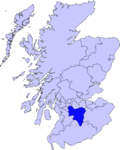| Caldermill | |
|---|---|
 The Trumpeter's Well and Calderbank | |
Location within South Lanarkshire | |
| OS grid reference | NS6641 |
| Council area | |
| Lieutenancy area | |
| Country | Scotland |
| Sovereign state | United Kingdom |
| Post town | STRATHAVEN |
| Postcode district | ML10 |
| Dialling code | 01357 |
| Police | Scotland |
| Fire | Scottish |
| Ambulance | Scottish |
| UK Parliament | |
| Scottish Parliament | |
Caldermill is a small settlement in South Lanarkshire, Scotland.
Contents
Caldermill is 3 miles (5 km) south-west of Strathaven, and is the next settlement a driver will come across after leaving Strathaven on the A71 westbound towards Kilmarnock. It is a hamlet of just a few houses. For children raised in Caldermill, the closest primary school is Gilmourton Primary, in the nearby hamlet of Drumclog, which is 2 miles (3 km) further along the A71 towards Kilmarnock. The nearest high school is Strathaven Academy, located in the town of Strathaven.




